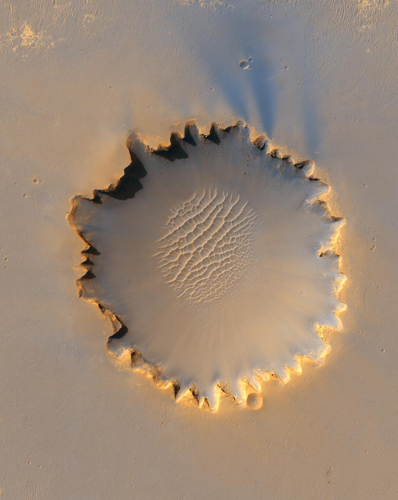|

Victoria provides Opportunity to view Mars' geological history
BY KEITH COOPER
ASTRONOMY NOW
Posted: 24 May, 2009
Opportunity’s two-year stay in Mars’ Victoria Crater is now bearing fruit, with the publication of the first major analysis of what the Mars Exploration Rover found.
Details present in the report featured in the 22 May edition of the journal Science describe a crater carved by wind and water erosion, and a strong indication that the water was mostly underground rather than running freely on the surface. The water appears to have come and gone several times billions of years ago, with the wind continuing the erosion until the present day.

Opportunity studying scalloped rocks inside Victoria Crater's Duck Bay.
Image: NASA/JPL–Caltech.
Opportunity arrived at the 750-metre wide Victoria Crater in September 2006 and cautiously drove in, inspecting layered rocks in steep cliff faces and shallow alcoves. The alternating cliffs, alcoves and outcroppings indicate that the crater has, over time, widened by a quarter as wind erosion has caused certain parts of the crater rim to crumble, filling in the crater bowl so it is now only 75 metres deep.
Opportunity spent considerable time examining one alcove in particular, nicknamed Duck Bay. The deeper into the crater the exposed sandstone rock goes, the older it is, and the rover detected more aluminium and silicon in the lower layers of Duck Bay, and less sulphur and iron. Opportunity also found relatively large ‘blueberries’ – small spherules of an iron-rich mineral called hematite, which forms in the presence of water.
However, in the higher layers and around the crater fewer and smaller blueberries were seen, indicating that the water action took place deep underground before the crater was excavated millions of years ago. On the approach to Victoria, Opportunity also found rocks containing minerals such as kamacite and troilite, which are common constituents of meteorites. It is tantalisingly possible that these are fragments of the rock that smashed into the Meridian Planum region on Mars to create Victoria all that time ago.

Victoria Crater imaged from orbit by the Mars Reconnaissance Orbiter.
Image: NASA/JPL/University of Arizona.
Many of the characteristics of Victoria Crater are similar to the much smaller Endurance Crater, which Opportunity explored shortly after bouncing down onto the surface in 2004. The two craters are six kilometres apart.
“It shows that the processes that we investigated in detail for the first time at Endurance Crater are regional in scale, [indicating that] the kinds of conclusions that we first reached at Endurance apply perhaps across Meridiani Planum,” says Opportunity’s Principal Investigator, Steve Squyres of Cornell University, USA.
Opportunity is now trekking across the red landscape to an even larger crater called Endeavour, which is 22 kilometres wide and currently still 16 kilometres away from the rover, its crater rim just beginning to peep over the horizon. Meanwhile, on the other side of Mars, Opportunity’s twin, Spirit, has got itself stuck in spot of bother: a sand trap that is holding the rover hostage as it spins its wheels. Opportunity fell prey to a similar sand trap that the mission team nicknamed Purgatory Dune, after it held the rover for six weeks in 2005 before it could work its way out.
“[Spirit] seems to be in a unique combination of soft, sandy material and slopes that we haven’t encountered yet,” says Cornell’s Jim Bell, who manages the colour panorama (Pancam) cameras on both rovers. “Neither one has been particularly problematic in the past, but the combination of the two has us bogged down. We’re not calling this purgatory for Spirit yet, but it has that potential.”

Spirit struggles in the deep, soft dust. Image: NASA/JPL–Caltech.
|



